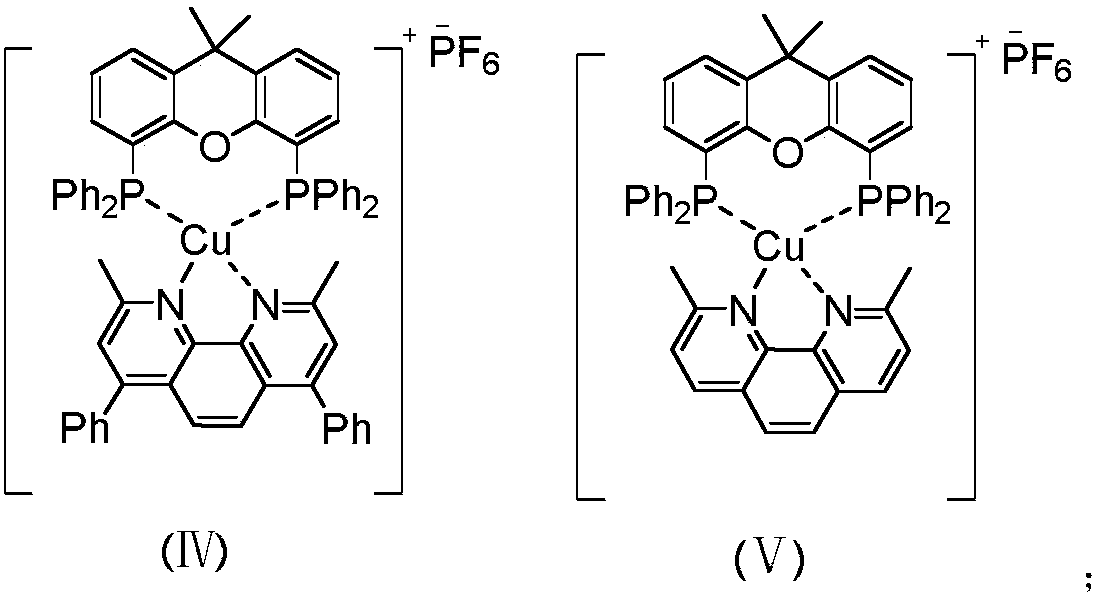Method for synthesizing benzofluorenone compound through photocatalysis
A technology for benzofluorenone and compounds, which is applied in the field of photocatalytic synthesis of benzofluorenone compounds, can solve the problems of high reaction temperature and poor functional group tolerance, and achieve mild reaction conditions, good substrate adaptability and high application prospects Effect
- Summary
- Abstract
- Description
- Claims
- Application Information
AI Technical Summary
Problems solved by technology
Method used
Image
Examples
Embodiment 1
[0034]
[0035] Add 0.3mmol of 1-(2-(phenylethynyl)phenyl)prop-2-en-1-one, 0.03mmol of copper photosensitizer (Ⅳ), and 0.9mmol of phenyltetrafluoroborate diazonium salt into a 15mL thick In a pressure-resistant reaction tube with a wall, under the irradiation of 15W blue LED light, react in 3mL solvent ethanol at 40°C for 2 hours. After cooling to room temperature, add two spoons (0.5 g, the same below) column chromatography silica gel (100-200 mesh) to the reaction solution, and remove the solvent by distillation under reduced pressure, and then obtain the structural formula (III- 1) The pure product shown (petroleum ether / ethyl acetate = 20:1 as eluent). The material was a yellow solid, 68% yield.
[0036] 1 H NMR (500MHz, CDCl3): δ = 8.26 (s, 1H), 7.97 (dd, J = 7.5, J = 1.5Hz, 1H), 7.76 (dd, J = 6.5, J = 0.9Hz, 1H), 7.65 –7.60(m,3H),7.51–7.42(m,5H),7.26–7.19(m,2H),6.35(d,J=7.5Hz,1H)ppm. 13 C NMR (125MHz, CDCl3): δ=193.2, 145.2, 137.4, 136.9, 136.5, 135.3, 134.70, 134...
Embodiment 2
[0038]
[0039] Add 0.3mmol 1-(2-(phenylethynyl)phenyl)prop-2-en-1-one, 0.03mmol copper photosensitizer (Ⅴ), and 0.9mmol p-methylphenyltetrafluoroborate diazonium salt Put it into a 15mL thick-walled pressure-resistant reaction tube, and react in 3mL solvent ethanol at 40°C for 2 hours under the irradiation of 15W blue LED light. After being cooled to room temperature, two spoons of column chromatography silica gel (100-200 mesh) were added to the reaction solution, and the solvent was removed by distillation under reduced pressure, and the pure product as shown in structural formula (III-2) was obtained by column chromatography separation. product (petroleum ether / ethyl acetate = 20:1 as eluent). The material was a yellow solid, 60% yield.
[0040] 1 H NMR (500MHz, CDCl3): δ = 8.21 (s, 1H), 7.85 (d, J = 8.5Hz, 1H), 7.74 (dd, J = 6.5, J = 1.0Hz, 1H), 7.65–7.61 (m ,3H),7.43–7.40(m,2H),7.32(dd,J=8.0,J=1.5Hz,1H),7.23–7.17 (m,3H),6.29(d,J=7.5Hz,1H), 2.40(s,3H)ppm. 13 C NMR...
Embodiment 3
[0042]
[0043] Add 0.3mmol 1-(2-(phenylethynyl)phenyl)prop-2-en-1-one, 0.015mmol copper photosensitizer (Ⅳ), and 0.9mmol p-chlorophenyltetrafluoroborate diazonium salt to In a 15mL thick-walled pressure-resistant reaction tube, under the irradiation of 15W blue LED light, react in 3mL solvent ethanol at 40°C for 2 hours. After cooling to room temperature, two spoonfuls of column chromatography silica gel (100-200 mesh) were added to the reaction solution, and the solvent was removed by distillation under reduced pressure, and then separated by column chromatography to obtain the pure product shown in structural formula (III-3). product (petroleum ether / ethyl acetate = 20:1 as eluent). The material was a yellow solid, 63% yield.
[0044] 1 H NMR (500MHz, CDCl3): δ = 8.21 (s, 1H), 7.89 (d, J = 9.0Hz, 1H), 7.75 (d, J = 7.0Hz, 1 H), 7.66–7.62 (m, 3H) ,7.45–7.39(m,4H),7.26–7.19(m,2H),6.33(d,J=7.5Hz,1H)ppm. 13 C NMR (125MHz, CDCl3): δ=192.8, 144.8, 137.8, 136.7, 136.53, 136....
PUM
 Login to View More
Login to View More Abstract
Description
Claims
Application Information
 Login to View More
Login to View More - R&D
- Intellectual Property
- Life Sciences
- Materials
- Tech Scout
- Unparalleled Data Quality
- Higher Quality Content
- 60% Fewer Hallucinations
Browse by: Latest US Patents, China's latest patents, Technical Efficacy Thesaurus, Application Domain, Technology Topic, Popular Technical Reports.
© 2025 PatSnap. All rights reserved.Legal|Privacy policy|Modern Slavery Act Transparency Statement|Sitemap|About US| Contact US: help@patsnap.com



